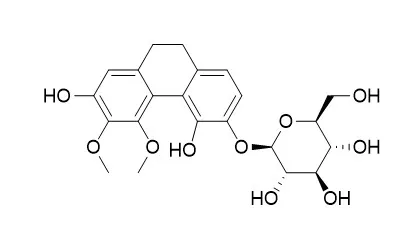| Structure Identification: |
| J Ethnopharmacol . 2014 Sep 11;155(2):1164-1170. | | Phenolic derivatives from the rhizomes of Dioscorea nipponica and their anti-neuroinflammatory and neuroprotective activities[Pubmed: 24973689] | | Ethnopharmacological relevance: Dioscorea nipponica (Dioscoreaceae) have been used as traditional medicines for diabetes, inflammatory and neurodegenerative diseases in Korea. The aim of the study was to isolate the bioactive components from the rhizomes of Dioscorea nipponica and to evaluate their anti-neuroinfalmmatory and neuroprotective activities.
Material and methods: The phytochemical investigation of 50% EtOH extract of Dioscorea nipponica using successive column chromatography over silica gel, Sephadex LH-20, and preparative high performance liquid chromatography (HPLC) resulted in the isolation and identification of 17 phenolic derivatives, including four new phenolic compounds (1-4). The structural elucidation of these compounds was based on spectroscopic methods, including 1D and 2D nuclear magnetic resonance (NMR) spectroscopy techniques, mass spectrometry, and optical rotation. All isolated compounds were evaluated for their effects on nerve growth factor (NGF) secretion in a C6 rat glioma cell line and nitric oxide (NO) production in lipopolysaccharide (LPS)-activated BV2 cells. The neurite outgrowth of compound 16 was further evaluated by using mouse neuroblastoma N2a cell lines.
Results: Three new stilbene derivatives, diosniponol C (1), D (2) and diosniposide A (3) and one new phenanthrene glycoside, Diosniposide B (4), together with 13 known compounds were isolated from the rhizomes of Dioscorea nipponica. Of the tested compounds (1-17), phenanthrene, 3,7-dihydroxy-2,4,6-trimethoxy-phenanthrene (16) was the most potent NGF inducer, with 162.35±16.18% stimulation, and strongly reduced NO levels with an IC50 value of 19.56 μM in BV2 microglial cells. Also, it significantly increased neurite outgrowth in N2a cells.
Conclusions: This study supports the ethnopharmacological use of Dioscorea nipponica rhizomes as traditional medicine. |
|






 Cell. 2018 Jan 11;172(1-2):249-261.e12. doi: 10.1016/j.cell.2017.12.019.IF=36.216(2019)
Cell. 2018 Jan 11;172(1-2):249-261.e12. doi: 10.1016/j.cell.2017.12.019.IF=36.216(2019) Cell Metab. 2020 Mar 3;31(3):534-548.e5. doi: 10.1016/j.cmet.2020.01.002.IF=22.415(2019)
Cell Metab. 2020 Mar 3;31(3):534-548.e5. doi: 10.1016/j.cmet.2020.01.002.IF=22.415(2019) Mol Cell. 2017 Nov 16;68(4):673-685.e6. doi: 10.1016/j.molcel.2017.10.022.IF=14.548(2019)
Mol Cell. 2017 Nov 16;68(4):673-685.e6. doi: 10.1016/j.molcel.2017.10.022.IF=14.548(2019)